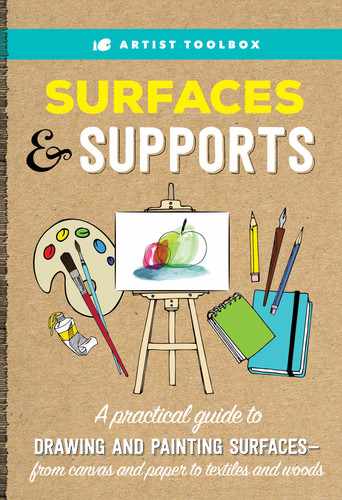CHAPTER 4:
Textiles
There are many advantages to textile painting. Fabric is lightweight but tough, so it doesn’t tear as easily as paper—and it is far less bulky than panels and canvas. You can also size it to your liking simply by cutting it. The surface might even offer a beautiful grained texture or luster to enhance your artwork. In this chapter, familiarize yourself with the following:
• Batik
• Additional Non-rigid Surfaces


TYPES OF FABRIC
Fabric is made up of woven fibers that create sheets of pliable material. Nearly any type of fabric can be used as a painting surface, from 100-percent cotton and silk to polyester and synthetic blends. Below are tips to keep in mind as you select your surface.

It’s best to keep your fabric pulled taut as you paint, which will keep it from moving and crinkling under your brush. You can suspend it between a frame using clothespins or clamps, or you can wrap and secure it around a board.
PAINTS & DYES
The most important quality of fabric paint is its flexibility. You can purchase paints formulated specifically for use on textiles, or you can alter acrylic paint with an additive to make it dry to a more flexible finish, allowing it to bend with the material’s surface. This additive is often called “textile medium” or “fabric medium.”
Unlike paints, which sit on the surface of the fibers like a film, dyes react chemically and bond with the fibers. They do not change the overall feel of the fabric. In general, dyes have a more fluid appearance and can produce soft edges and gradations, whereas paints can yield sharper strokes.
Fabric paint is a thin, acrylic-based craft paint available at art stores. Mix these paints on a simple plastic or aluminum palette to create new variations of color, and thin them with textile and fabric medium.
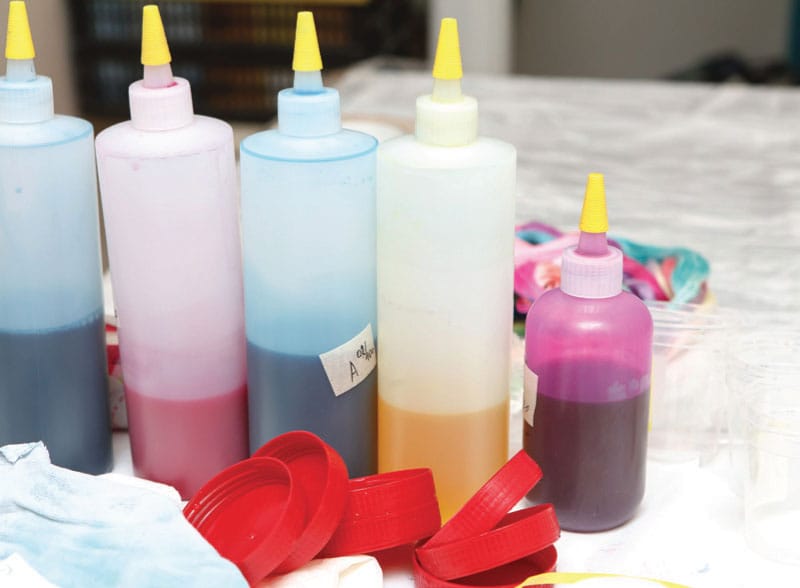
Dyes are very thin, colored fluids that artists prepare and disperse from nozzled bottles. Dyes call for safety precautions, such as masks and gloves. Be sure to read the guidelines before you begin.
FOLK ART-INSPIRED FLOWER ON COTTON

Begin by wrapping your pre-washed and dried fabric around a board.

If you want to sketch in guidelines for your design, use a chalk pencil. When working on dark fabrics, use white. When working with thin fabric, you can also slip a sketch between your board and fabric for tracing.
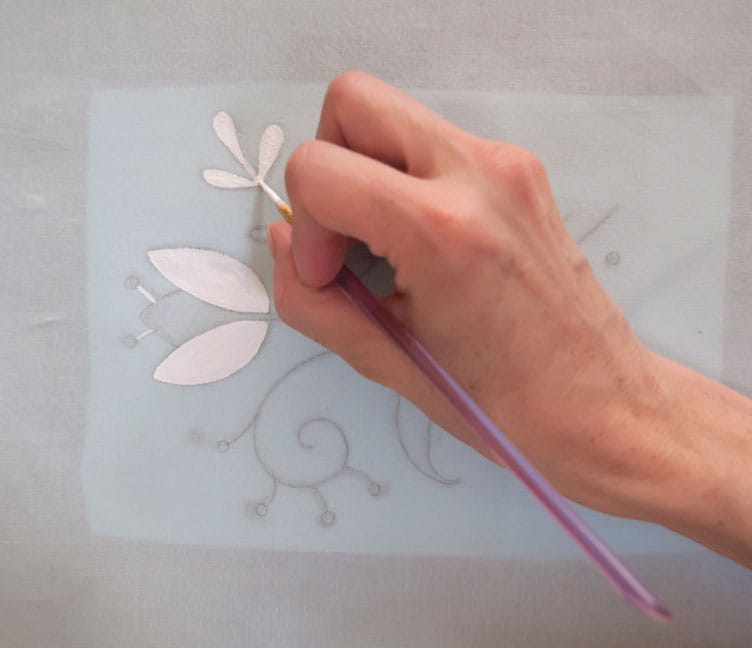
Thin the fabric paint with medium so that it flows smoothly when you stroke. Vary the line width of your strokes for interest, and remember that imperfections will give your design a charming hand-painted quality.
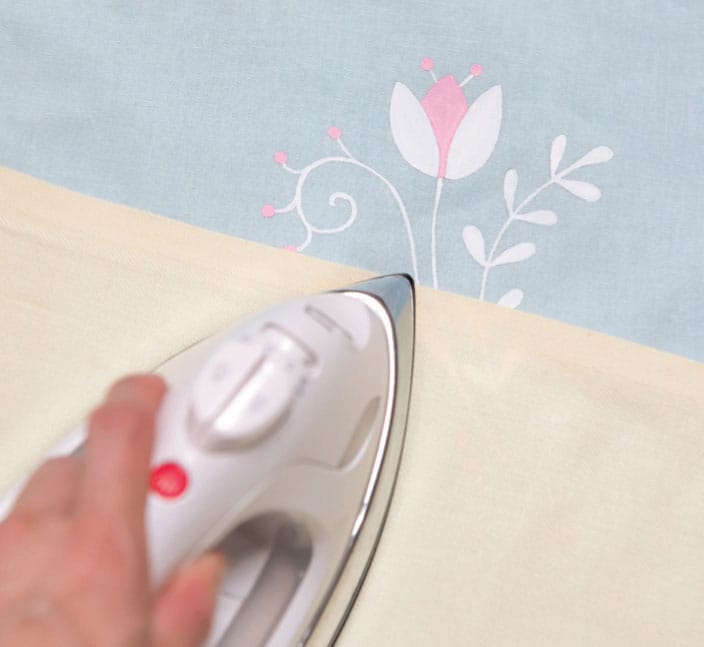
Remove wrinkles and set the fabric paint by using a pressing cloth between the surface of the painting and a hot iron. (The iron should be set to the appropriate temperature for the fabric.) You can also iron the back of the painted fabric. Setting with heat will allow you to wash the fabric without disturbing the paint.
BATIK
Originating from the island of Java in Indonesia, batik is an Asian art form that involves creating designs on fabrics using dyes and wax resists. The method works with a variety of fabrics, from cotton to silk. Batik is used to create works of art as well as decorative cloth for garments.

The most important tool in batik is the tjanting, which holds melted wax (usually beeswax and paraffin) and disperses it in dots and thin lines. The fabric is then dyed, preserving the original color of fabric beneath the wax. Artists might then choose to add more wax and dye again for multiple colors. Ultimately, artists boil out the remaining wax once the design is complete.

Tjaps are another tool often used by batik artists. These copper tools can stamp wax (and even paint) onto fabric to create intricate patterns across lengths of material.

Traditional batik generally uses floral motifs, but you can experiment with the technique to create modern designs and even scenes.
SILK PAINTING
Silk is made from woven fibers produced by silkworms or moth caterpillars, creating fabric that is soft but strong and with a unique luster. Painting on silk is an Asian art form that dates to before 100 BC. The process involves applying pigments to silk in concert with gutta—a water-based gum that acts as a resist, stopping the flow of pigment across the silk.

PAINTS & DYES FOR SILK
Silk can be colored with paints or dyes, but both need to be set with either steam or a hot iron to make the colors permanent and washable. Silk paints are water-based, nontoxic, easy-to-use colors that you dilute with water, and they can be heat-set with a dry iron. They are generally less expensive than silk dyes, and they are a little easier to work with because they mix and clean up easily with water. However, dyes yield richer colors.
Silk dyes are professional chemical colors that you thin with a solution of water and rubbing alcohol. They are transparent and blend easily, and they flow beautifully when applied to the silk. The most concentrated types of dyes must be steam-set, but some brands can be set with a liquid fixative or heat-set with an iron.
TIP
Dyes and resists are strong chemicals, so take some precautions when working with them. Always read the directions before using any product, especially oil-based gutta resists.
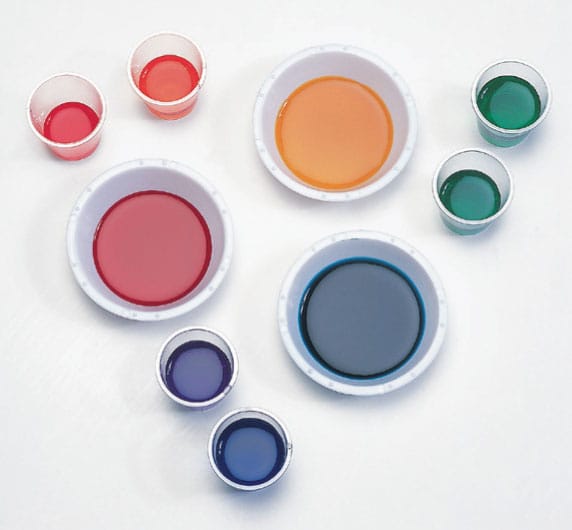
TYPES OF SILK
Silk comes in a variety of weights (5mm, 8mm, and higher) and types of weave, and each type varies in feel and in the way that it reacts to colors. China silk (also called “habotai”) is the best type for beginning projects. It’s economical and has a smooth surface and an even weave, so the colors flow evenly. Crepe de Chine is a slightly heavier silk used for scarves and other articles of clothing. Silk charmeuse is also heavier, with a very soft feel and a beautiful drape. Chiffon, georgette, and organza are translucent silks that cause the dye colors to appear light and delicate. Twill, jacquard, and dupioni are textured silks with a subtle pattern on the surface.
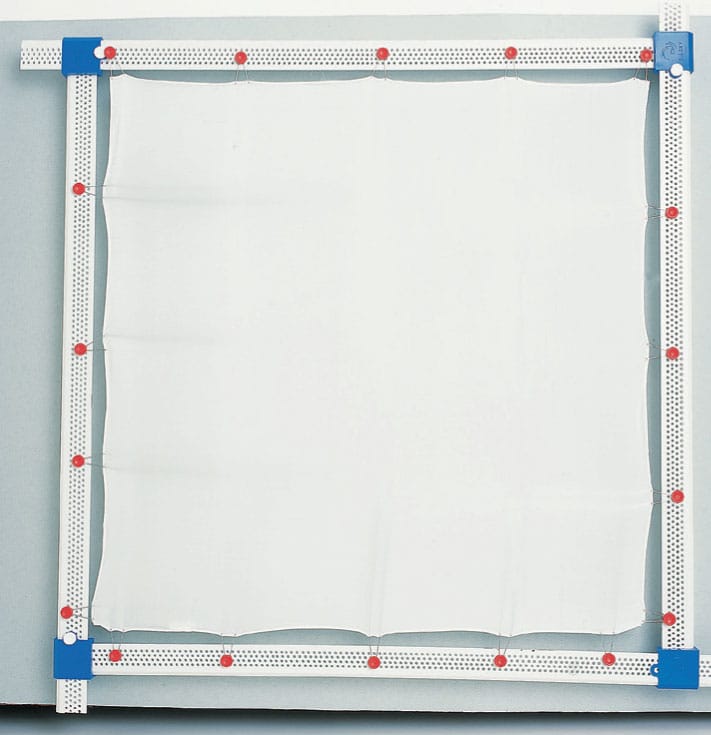
You must always stretch the silk on a frame before painting. Stretching makes the silk taut so that the colors won’t puddle, and the frame holds the silk away from your work surface.

Sketch your design onto the silk using a washable pencil; then trace over the lines with clear gutta. Enclose all the shapes so that the dyes won’t bleed into the wrong area.

Begin painting by first wetting the area with water; then carefully apply a little color from one side of the area to the other, blending as you go. Blot off any excess water with a dry cotton swab. To get a graduated light-to-dark effect, wet the silk and apply a pastel (diluted) color. While the color is still slightly damp, add a darker shade of the same color along the edge, letting the two shades blend together. Repeat with an even darker shade if desired. Shown here, gradations of color create dimension in the flower petals.
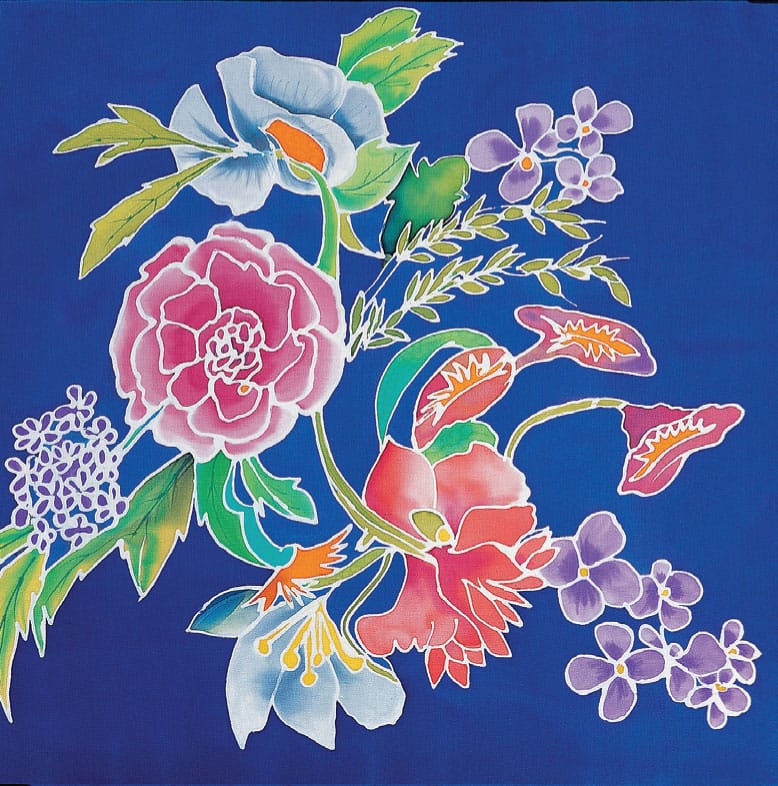
When the color is completely dry, remove the silk from the frame. You can either remove the gutta now, or wait until after you have set the colors.

Steam-set the dyes following the dye manufacturer’s instructions, rinse with water and mild soap, and blot out the moisture by rolling the silk in a towel. Use a dry iron to smooth over the silk and permanently set the colors.

For this piece, Christine Mariotti used gutta as a design element rather than as a resist. She painted the background first and then drew the outlines of the bird and flowers with gold gutta. The stronger colors in the fuchsias and hummingbird make them stand out against the blended pastel background.
ADDITIONAL NON-RIGID SURFACES
Because acrylics are water-based, flexible, and durable, they are a top choice of paint for working on non-rigid surfaces such as animal hides and synthetic fabrics. To make any acrylic paint even more suitable for these surfaces, remember that you can add fabric or textile medium to reduce the chance of cracking and chipping. Below are a few non-rigid surfaces that can serve as unconventional supports for works of art. Keep in mind that these surfaces must be clean, uncoated, and dry in order to properly accept paint.
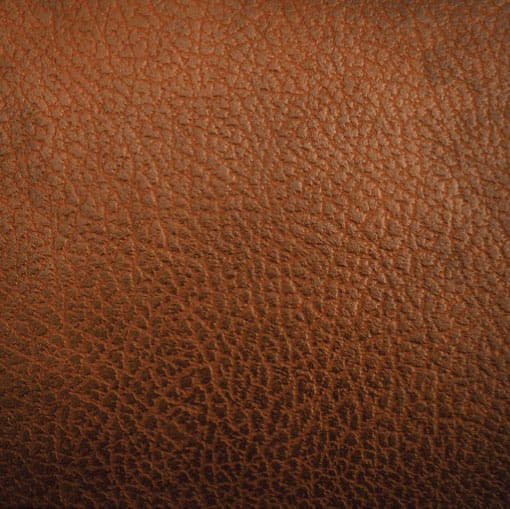
Leather

Suede

Polyester

Vinyl
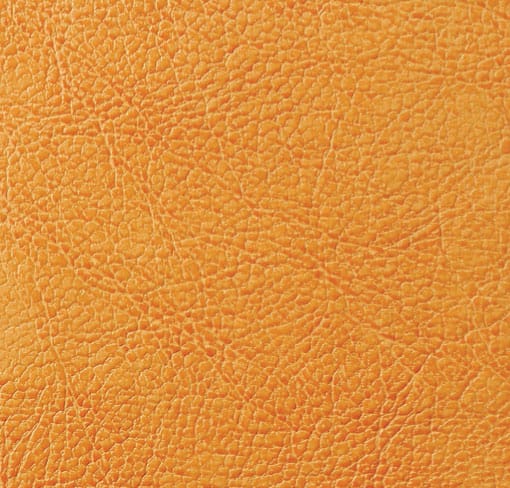
Faux Leather Vinyl

Cork Fabric
TIP
To keep non-rigid material steady and flat while painting, you can either wrap it around a board or suspend it in a stretcher, such as a silk stretcher frame. A stretcher is a great way to achieve a taut surface and avoid wrinkles.
